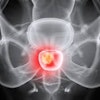CHICAGO - Acute toxicities experienced by women undergoing chemoradiation treatment for gynecologic malignancies were well-tolerated in a recent study, according to a presentation Wednesday at the 2007 RSNA meeting. In addition, toxicity was no worse than treatment with radiation alone, the researchers reported.
Dr. Jeffrey Olsen and colleagues at Washington University in St. Louis assessed the aftereffects of postoperative pelvic intensity-modulated radiation therapy (IMRT) with and without chemotherapy for women with endometrial or cervical cancer.
For this retrospective study, the records for 31 women with stage IB-IVB endometrial cancer and six women with stage IB1-IIIC cervical cancer were reviewed. They all had total abdominal hysterectomy and bilateral salpingo-oophorectomy (TAH/BSO), as well as lymph node dissection and postoperative radiotherapy.
"The treatment planning goal was to cover the tissue at risk for recurrence, while minimizing the radiation dose to the bladder, bowel, and bone marrow," Olsen said.
The treated volume included the pelvic and para-aortic nodes in 30 cases and the pelvic nodes alone in seven cases. Thirty-six patients also received high-dose radiation vaginal cuff brachytherapy. The median prescription dose was 5,120 cGy.
In terms of chemotherapy, 22 patients received carboplatin and paclitaxel in conjunction with chemotherapy. Acute toxicity was measured using the Radiation Therapy Oncology Group (RTOG) scale.
According to the results, all women completed the radiation course without interruption. Twenty-one of the 31 finished the chemotherapy course, although it was delayed in three patients. Acute grade III or grade IV hematologic toxicity occurred in eight of 22 women who received chemotherapy and five of 15 who did not. None of the patients experienced grade III or grade IV gastrointestinal or genitourinary toxicity.
"The conclusions to be drawn from this are that concurrent adjuvant IMRT and chemotherapy following surgery is generally well-tolerated," Olsen said. "Acute toxicity experienced during adjuvant chemoradiation treatment is acceptable compared to radiation treatment alone."
RSNA session moderator Dr. Nina Mayr asked about the frequency of nausea in the patients who received IMRT. Olsen said his group did not specifically track the grade of nausea, but that it was not a common side effect that they saw. They had more instances of post-treatment diarrhea, he added. In answer to a session attendee's question, Olsen said fiducial markers were not used in these patients.
The RTOG is currently in phase II of a clinical trial on IMRT for endometrial and cervical carcinoma (RTOG 0418). As for June 2007, the endometrial arm of the study was close to accrual. RSNA session co-moderator Dr. Kristin Bradley noted that fiducial markers are being used in RTOG 0418.
By Shalmali Pal
AuntMinnie.com staff writer
November 28, 2007
Related Reading
Drinking linked to endometrial cancer risk, September 20, 2007
Post-treatment PET scans can reassure cervical cancer patients, November 20, 2007
SUV on FDG-PET can predict cervical cancer prognosis, September 19, 2007
Pilot study shows link between FDG uptake and biomarkers of cervical cancer, September 11, 2007
Copyright © 2007 AuntMinnie.com



















